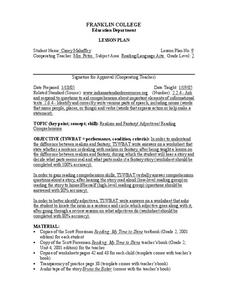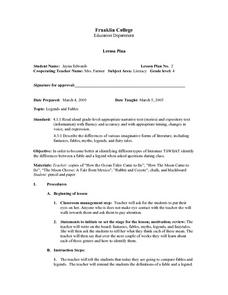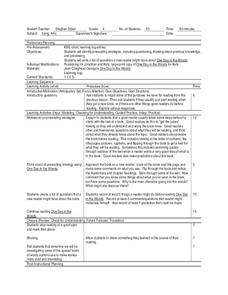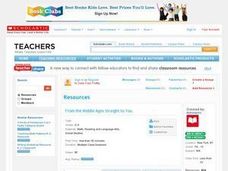Curated OER
Song Writing
In this music worksheet, students identify specific tips for composing a song. They use strophic form where each verse has the same melody. Students also select a chord sequence and use cadences at the end of each phrase and modulations...
Curated OER
6-8 Meter Madness
Students identify time signatures, the down beat, and begin to understand conducting patterns. In this meter patterns lesson, students identify the signs for 2/4, 3/4, and 4/4 and play an excerpt from a song. Students use tennis balls to...
Curated OER
Identifying and Writing the Letter M and m School/Home Links
In this letter writing and recognition activity, students practice writing the letter M and m three times each after their home learning partner reads the activity to them. They write the names of the M months, and four M items they find...
Curated OER
Sequence, Predict, Infer: Pink and Say
Practice sequencing with your 2nd graders via Patricia Polacco's Civil War book Pink and Say. Begin with a blindfold and a bag of mystery items. Connect their use of clues to identify what they can't see with the skill of making...
Curated OER
SOAPS Primary Source "Think" Sheet
Planning on using primary source materials? Introduce your class members to SOAPS, a learning exercise that models how to analyze and reflect on primary source materials. Readers name the document, identify the subject (S), the...
Curated OER
Problem Solving
Fourth graders complete a worksheet identifying unnecessary information regarding 8 different math problems. In this problem solving lesson, 4th graders discuss the meaning of colors on a spotlight in order to develop the skill of how to...
Curated OER
Realism and Fantasy
Second graders listen to the story, Bruno the Baker, where some parts seem real and some seem fake. They must identify the parts of the story as realism or fantasy. An interesting way to teach young readers these two concepts.
Curated OER
Friendly Letter Writing and Sentence Structure
Explore communication through writing by analyzing individual sentences with young writers. They practice writing compound sentences and identifying sentence fragments. The next step has them learn the five parts of a friendly letter....
Curated OER
Naming Letters School/Home Links
Send your kindergarten class home with this review sheet. They should read the name of each letter shown and point to it. Then have them identify their favorite letter and write it five times.
Scholastic
Writing Letters of Gratitude
A lesson begins with a discussion on gratitude—what does it mean, and for who are learners thankful? Scholars share their thoughts and feelings then choose a community worker to which they wish to share their gratitude. Writers compose a...
Curated OER
The Letter "L"
Students practice using the letter "L." In this letter "L" instructional activity, students complete a worksheet (not included) on which they identify pictures of items that begin with the letter "L."
Curated OER
Parts of a Friendly Letter
The art of writing a letter has not been lost to email and texting! Teach kids how to format a friendly letter with a presentation about the parts of a letter, as well as prompting them to write a letter about their favorite holiday.
Curated OER
Legends and Fables
Fourth graders identify and discuss the differences between legends and fables. They define fable and legend, then as a class take turns reading our books. Students select two of the stories, and complete a Venn diagram, comparing one...
Curated OER
Writing Process
Fourth graders identify the benefits of using a field guide for nature observations. They then field trip to a natural setting to prepare for writing. They record their observations, and write a journal entry using the steps of the...
Curated OER
Prereading
Fourth graders participate in think-pair-share reading strategy in this lesson. They identify their purpose for reading as well as purposes for reading fiction/nonfiction. They list and discuss several prereading activities, and then...
Curated OER
School-Home Links: Mixed Alphabet
In this school-home links mixed alphabet review worksheet, students point to each of the 36 uppercase and lowercase letters and identify them with a caregiver.
Curated OER
Talk-About-It
Students identify and interpret how it is important to know class rules and the difference between "Big" and "Small" problems. They identify what the problem is, how the problem makes them feel, how the problem was solved, and how to...
Curated OER
Citizens for Responsible Change
Third graders write a petition to a school figure, get signatures from other students, share the petition with the appropriate authority, and then work as leaders to carry out the group's solution.
Curated OER
Alphabetical Order
Students participate in a teacher lead teacher activity. They sit in a circle while the teacher places four ABC cards down and has a student identify the missing letter. After the demonstration, they are broken into small groups to...
Curated OER
No Title
Fourth graders identify the characteristics of a good paragraph and find those characteristics in a good paragraph from the books, "One Day in the Woods," by Jean Craighead George and "Why Do Leaves Change Color," by Betsy Maestro.
Curated OER
No Title
Fourth graders identify and practice a variety of prereading strategies to assess how to ask questions that a new reader might ask about the book, "One Day in the Woods." They skim the book, brainstorm the topic of the book and preview...
Curated OER
From the Middle Ages Straight to You
Students read a "letter" from Dr. Suess' Bartholomew Cubbins and note differences between their lives and Bartholomew's. They utilize prewriting strategies to draft a letter of response to Bartholomew.
Curated OER
Narrative Literature Response Letters: Original Lesson Plan
Readers write a formal letter to an author offering an alternative ending to a story the author has written. First, the class reads a story or novel. Upon finishing the reading, they are introduced to the format of a formal letter. They...
Curated OER
Maniac McGee: Find Your Match
Students explore similarities and differences between people. In this diversity and literacy lesson, students read Maniac McGee and consider character traits. Students play a game in which they locate classmates with similarities and...























